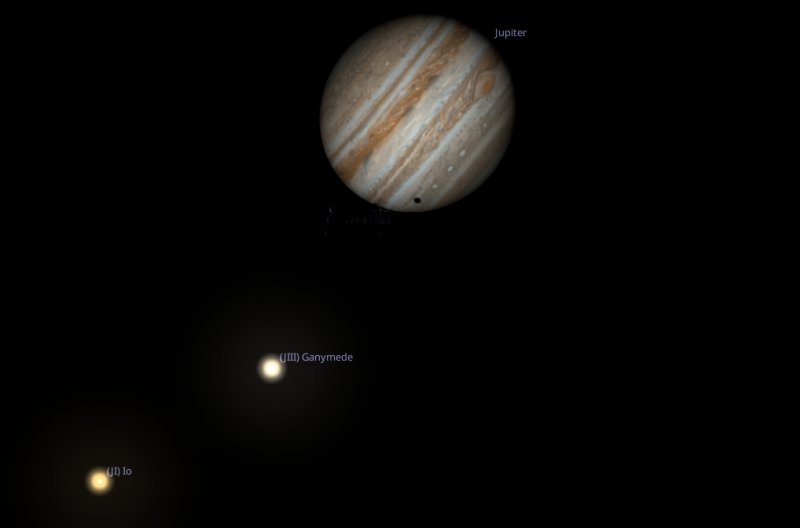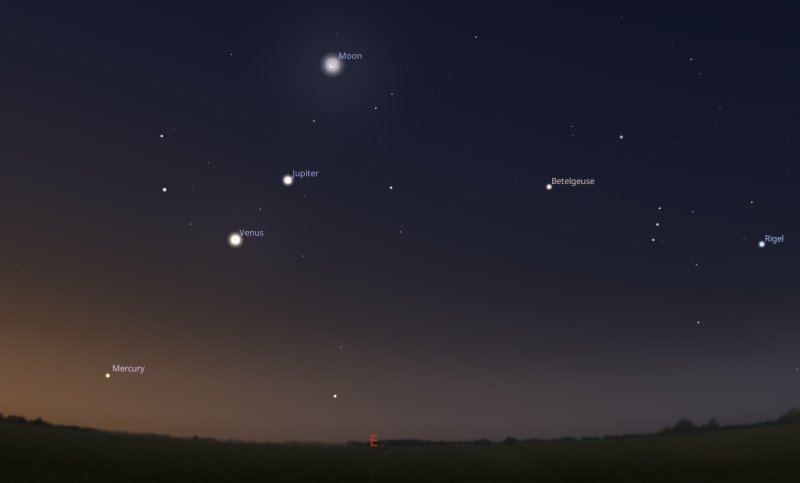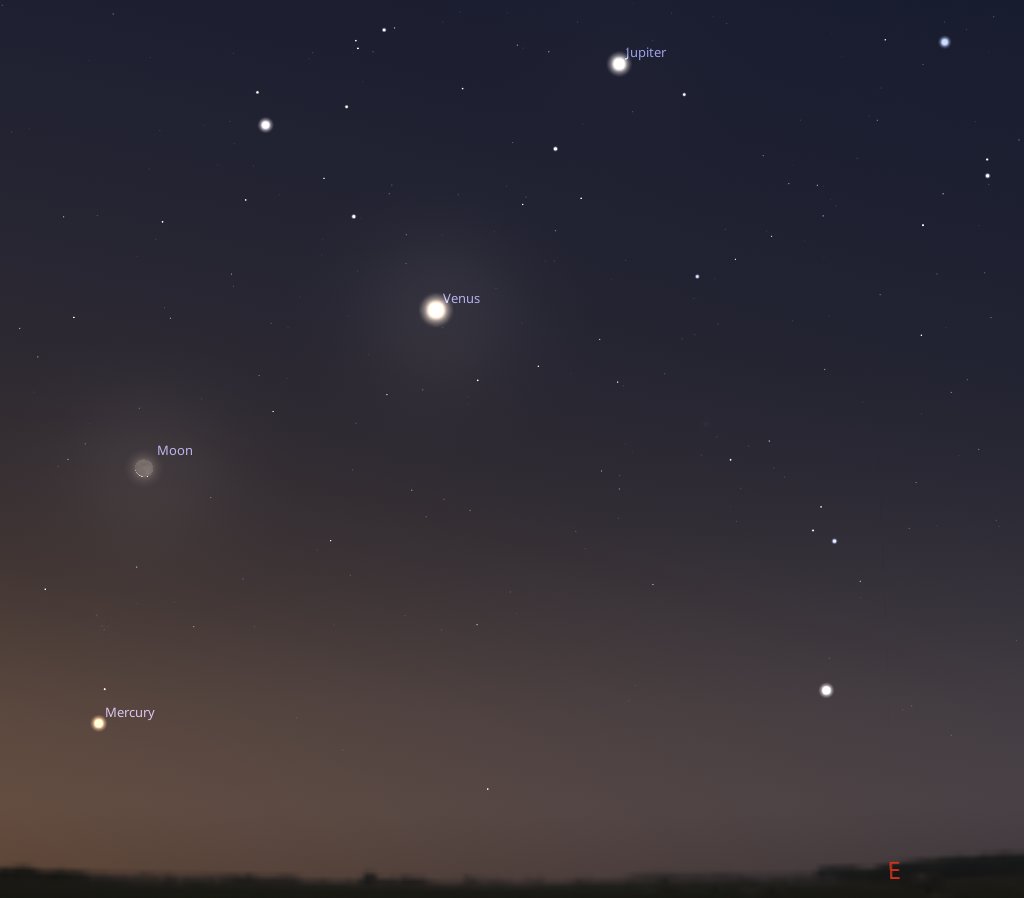|
Monday 25th to
Sunday 31st August 2025 |
| |
|
Last week I had everyone up early at
stupid-o'clock to try and see a thin waning crescent Moon in the dawn sky.
This week you could try catching a thin waxing crescent Moon in the evening
sky. The phase is now called "waxing" or "becoming brighter" as there was a
New Moon on 23rd August and it is now heading towards a Full Moon. |
| |
|
Venture outside at sunset on Tuesday 26th,
say from about 8pm and look towards the west south west. A waxing 12%-lit
crescent Moon will be just about to set below the horizon. Slightly above
and to the right of the Moon, it should be possible to spot Mars, shining at
a magnitude of +1.6 and because the Sun will have disappeared below the
horizon, it would be totally safe to use your telescope for a better view of
the Red Planet. |
| |
 |
| |
|
If you have a decent-size telescope and you
are feeling the urge for an early morning start, aim it towards the south
west just before 5am on Tuesday 27th and locate Saturn. Saturn's largest
moon Titan will be starting to enter the shadow of the gas giant, which
means that Titan will be eclipsed by the planet and will gradually become a
"quarter" and then "crescent" phase. |
| |
 |
| |
|
Alternatively, point your telescope towards
the east around 4am on Sunday 31st to catch the shadow of Jupiter's largest
moon Ganymede as it transits in front of the planet. The transit actually
begins at 3.30am and lasts until 6.30am, so you could pick any slot between
those times if you oversleep a bit! |
| |
 |
|
Monday 18th to
Sunday 24th August 2025 |
| |
|
I mentioned spotting Mercury in the dawn sky
last week. On Tuesday 19th, the planet reaches its greatest western
elongation, which in practice means that it will be in the best position for
viewing, appearing above the eastern horizon about an hour before sunrise.
Mercury will have a magnitude of around +0.1 |
| |
|
If you look towards the east around 5am on
the Tuesday morning, there will actually be a veritable visual feast for the
naked eye, as above and slightly to the right of Mercury, you will be able
to see Venus, Jupiter and a 10%-lit waning crescent Moon forming a straight
line. Venus will have a magnitude of -3.9 and Jupiter around -1.8 so
everyone will be very bright and easy to spot. |
| |
 |
| |
|
When you've finished with them, look further
to the right to catch the whole of Orion, with the bright stars Betelgeuse
and Rigel. The constellation will look like it is on its side at this time
of year and be quite close to the horizon. During the winter months, it
appears higher in the night sky and is then better-placed for detailed
viewing. |
| |
|
You should be able to notice that Betelgeuse
has a reddish tint, while Rigel is more blueish. This is because Betelgeuse
is a big old red giant star, but Rigel is much younger and hotter. |
| |
|
If you repeat the exercise at 5am a couple of
days later, on Thursday 21st, the three planets will appear near enough in
the same position, but the Moon will now be found just above Mercury and our
natural satellite will be a very hard-to-spot 4%-lit crescent as it heads
towards a New Moon phase on 23rd. |
| |
 |
|
Monday 11th to
Sunday 17th August 2025 |
| |
|
If you are up very early on Monday 11th,
around 4am, it will still be dark, with Jupiter and Venus shining very
brightly towards the east north east. Jupiter will have a magnitude of
about -2.0, while Venus, just to the right of Jupiter, will be even brighter
at a magnitude of -4.0 |
| |
 |
| |
|
Although the two planets look very close
together because of the angle you are viewing them at from the Earth, in
reality they are many millions of miles apart. Venus is a rocky planet
within what is known as the Inner Solar System that stretches out as far as
the Asteroid Belt. Jupiter, being one of the huge gas giants, lives in the
Outer Solar System beyond the Asteroid Belt. |
| |
|
If you look to the right of the pair, you
should be able to see the constellation of Orion on its side, closer to the
horizon. The red giant star Betelgeuse will be easy to identify. |
| |
|
Stay outside until about 5am to catch planet
Mercury popping up above the east north east horizon. It will be much
harder to observe in the dawn sky with a magnitude of around +2.0 and as the
Sun will be rising in the same place, please don't be tempted to risk using
a telescope to obtain a better view! |
| |
 |
| |
|
On a completely different note, the evening
of Tuesday 12th sees the peak of the annual Perseids meteor shower. At
11pm, the radiant point where the shooting stars appear to originate from,
will be located towards the north east, a little below the obvious "W" shape
of the constellation Cassiopeia. Unfortunately, a waning gibbous Moon
rising above the horizon towards the east will create some light pollution. |
| |
 |
|
Monday 4th to
Sunday 10th August 2025 |
| |
|
If you venture outside any night next week,
Saturn will be an easy target, shining at a magnitude of around +0.7 and at
midnight, the planet will have just risen above the east south east
horizon. It then spends the rest of the night moving across the sky towards
the west. |
| |
 |
| |
|
If you've brought your telescope out, planet
Neptune can be found just above Saturn. It's current magnitude of about
+8.0 makes is much harder to spot! |
| |
 |
| |
|
While your telescope is aiming in that
direction, it should be possible to observe some of Saturn's many moons.
Unfortunately its famous dust rings are not best-placed at the moment for
observing from the Earth. |
| |
 |
| |
|
At the end of the week, we have a Full Moon.
The Moon will be visible most of the night as it travels from east to west
and the light pollution from it, makes this the worst time possible to go
looking for faint deep sky objects. |
| |
|
So instead, why not see if you can experience
that "Moon illusion" that I have mentioned before, where as the Moon rises
above the horizon, it looks artificially large because your brain plays a
trick on you. |
| |
|
On the evening of Thursday 7th, look towards
the south east just as it's getting dark, around 9.30pm and our celestial
neighbour should be pretty obvious! If you keep watching the Moon later
into the night, as it climbs higher in the sky, it will appear to go back to
its normal size. Of course, it doesn't really change size - it is just an
optical illusion! |
| |
 |
|
Monday 28th July
to Sunday 3rd August 2025 |
| |
|
Just as it's getting dark on the evening of
Monday 28th, say around 9.30pm, look towards the west to observe a waxing
crescent Moon disappearing below the horizon, with planet Mars a little
above and to the right of it. |
| |
 |
| |
|
The evening of Wednesday 30th into the early
hours of Thursday 31st sees the peak of the Southern Aquariid meteor
shower. Around midnight, the constellation of Aquarius, where the radiant
point (or origin) of the meteor shower is located, will be found towards the
south east. It can be a great shower to watch with a Zenith Hourly Rate of
around 25.....in plain English, that means on average there can be up to 25
shooting stars per hour if conditions are working in your favour. |
| |
 |
| |
|
Venture back outside again on the Thursday
evening, around 11pm, to catch Saturn popping its head above the eastern
horizon. Aquarius will be to the right, so although past its peak, you may
still catch a few meteors from the shower if you keep an eye in that
direction. |
| |
 |
| |
|
Moving into August and swapping over to an
early morning, look towards the east around 5am on Sunday morning to see
Jupiter and Venus rise above the horizon. Both will be very obvious, with
Jupiter around a magnitude of -1.8 and Venus to the right of it, shining at
-3.9 which is even brighter. No telescope required for this one and also
not recommended as the Sun will be rising in the same area of the sky and
you must never risk catching an accidental glimpse of it in your eyepiece! |
| |
 |
|
Monday 21st
to Sunday 27th July 2025 |
| |
|
We'll start with a bit of a visual challenge
for early risers, around 4am on Wednesday 23rd. Look towards the north east
to see a very bright, magnitude -1.8 Jupiter. Not much of a challenge
there, but just above Jupiter will be a hard-to-spot thin 3%-lit waning
crescent Moon. Look further to the right to find an incredibly bright,
magnitude -4.0 planet Venus. |
| |
 |
| |
|
A constellation is a group of visible stars
that form a perceived shape - often animals or mythological creatures and
they can date back thousands of years. In 1922, the International
Astronomical Union formally adopted the current list of 88 different
constellations. There are other patterns of stars that form
easily-recognisable shapes that astronomers use to find their way around the
night sky - these are called "asterisms" and they may be part of a larger
constellation. |
| |
|
One such example is known as the "Teapot" and
it is part of the constellation Sagittarius. Towards the end of the week,
if you look towards the south around midnight, Sagittarius will appear close
to the horizon and the "Teapot" asterism should be obvious......it looks
like a teapot with the handle, lid and spout! |
| |
 |
| |
|
A little to the right of the teapot's lid are
a couple of Messier objects to aim your telescope towards - M8 "The Lagoon
Nebula" and M20 "The Trifid Nebula". M8 is classed as an emission nebula,
where stars are created and with a magnitude of about +4.6 you might just be
able to make out a faint fuzzy blob with the naked eye from a very dark
location. M20 is another emission nebula, but with a magnitude of +6.3 you
will definitely need your telescope or binoculars for that one! |
| |
 |
|
Monday 14th
to Sunday 20th July 2025 |
| |
|
If you pop outside around 1am on Wednesday
16th, a 71%-lit waning gibbous Moon will have risen above the horizon
towards the east south east. A little below and to the left of it, you
should be able to locate Saturn shining quite brightly and a much
harder-to-see planet Neptune. Neptune has a magnitude of around +7.0 so you
would need a telescope to spot that one. |
| |
 |
| |
|
During the week, the Moon will have gone
through its last quarter phase, when it is 50%-lit, so if you go back
outside around 2am on Sunday 20th (what will then be) a 27%-lit waning
crescent Moon rises above the horizon towards the east north east. A little
below and to the left of the Moon will be the Pleiades open cluster of stars
and below that, planet Uranus. Uranus will have a similar magnitude to
Neptune, so it's "telescope time" again! |
| |
 |
| |
|
Talking of telescopes, at the beginning of
August, I am running a "Telescope Masterclass" at the Ham Hill Visitor
Centre, due to popular demand after the annual series of "Stars Over
Somerset" evenings. The date for your diary is Saturday 2nd August, 10am to
4pm. |
| |
|
The day is
suitable for anyone thinking
of investing in a telescope or wanting to get to grips with an instrument
they already have collecting dust in the cupboard! It will include talks
about the different types of telescopes and accessories available, together
with practical demonstrations. You are welcome to bring your own telescope
along for a health-check and to acquire tips on how to use it successfully. |
| |
 |
| |
|
To reserve places, please contact Paul McNeil
at Ham Hill on 07973
887129 or via email to
countryside@somerset.gov.uk Tickets are £10. |
|
Monday 7th
to Sunday 13th July 2025 |
| |
|
At the very beginning of the week, there is
an excellent opportunity to spot the International Space Station. At 1am on
Monday 7th, the ISS will appear towards the west south west and pass just to
the left of the red giant star Antares, before travelling directly overhead
and then disappearing towards the east seven minutes later. |
| |
 |
| |
|
Antares has a magnitude of near-enough +1.0
which makes it the fifteenth brightest star in the night sky. It is
actually classed as a variable star and it's magnitude does slowly change a
bit. By contrast, the ISS will have a magnitude of about -3.9 on Monday
evening, making it far brighter than Antares. |
| |
|
If you go back outside at 11pm on the Monday
evening, Antares will now be located more towards the south and this time,
it will appear very close to a 91%-lit waxing gibbous Moon. |
| |
 |
| |
|
Repeat your observing at 11pm again 3 days
later, on Thursday 10th, to see what will then be a Full Moon rising above
the horizon towards the south east. Because it will be close to the
horizon, you will experience the phenomenon called "moon illusion" that I
mentioned the other week, where our neighbour appears much larger than it
really is. |
| |
 |
| |
|
Change your gaze to the west a few minutes
later to catch the ISS rising above the horizon again at 11.22pm. This time
it passes very close to the fourth brightest star in the night sky, the red
giant Arcturus, before disappearing towards the east six minutes later. |
| |
 |
|
Monday 30th June
to Sunday 6th July 2025 |
| |
|
A little challenge for telescope users around
2am on Monday 30th June. Look towards the east south east to see Saturn
shining at a magnitude of around +0.7 - no telescope needed for that one!
Just above and to the left of Saturn will be Neptune at a much fainter +7.9
which would be invisible to the naked eye. |
| |
 |
| |
|
Aiming your telescope towards Saturn should
show its rings of dust at a 45 degree angle and some of the gas giant's many
moons. |
| |
 |
| |
|
Although Neptune is the third-largest planet
in our Solar System, its huge distance from us makes it appear very small
and it is so far away from the Sun, that it is poorly illuminated. In fact,
Neptune is the only planet that was not first discovered by direct
observation! |
| |
|
In the early 1800s, an astronomer named
Alexis Bouvard tabulated the orbit of Uranus and noticed irregularities,
concluding that they must be caused by the gravitational pull of another
unknown planet. Various other astronomers made calculations of where
Neptune would be and it was finally observed using a telescope in 1846.
Neptune's largest moon Triton was discovered shortly afterwards, but it was
not until the 20th century that we identified its other moons. |
| |
|
The Voyager 2 space probe flew past Neptune
in 1989 and images of the planet reveal a large dark spot. The planet
appears pale blue due to the presence of Methane in its upper
atmosphere.....I guess if you could visit Neptune, it wouldn't smell too
good! |
| |
 |
| |
|
Neptune image courtesy of NASA |




























